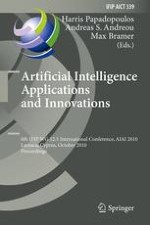The abundance of information and increase in computing power currently enable researchers to tackle highly complicated and challenging computational problems. Solutions to such problems are now feasible using advances and innovations from the area of Artificial Intelligence. The general focus of the AIAI conference is to provide insights on how Artificial Intelligence may be applied in real-world situations and serve the study, analysis and modeling of theoretical and practical issues. This volume contains papers selected for presentation at the 6th IFIP Conference on Artificial Intelligence Applications and Innovations (AIAI 2010) and held in Larnaca, Cyprus, during October 6–7, 2010. IFIP AIAI 2010 was co-organized by the University of Cyprus and the Cyprus University of Technology and was sponsored by the Cyprus University of Technology, Frederick University and the Cyprus Tourism Organization. AIAI 2010 is the official conference of the WG12.5 “Artificial Intel- gence Applications” working group of IFIP TC12, the International Federation for Information Processing Technical Committee on Artificial Intelligence (AI). AIAI is a conference that grows in significance every year attracting researchers from different countries around the globe. It maintains high quality, standards and welcomes research papers describing technical advances and engineering and ind- trial applications of intelligent systems. AIAI 2010 was not confined to introducing how AI may be applied in real-life situations, but also included innovative methods, techniques, tools and ideas of AI expressed at the algorithmic or systemic level.
